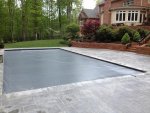bk406 said:
Just a note to those in snow country. Those auto covers are not designed to bbe used in winter where there is a snow load. You would still need a safety cover like a Loop_loc or a tarp and water bags.
I have to comment on this because it is just not true for all covers and bad advice to boot. I speak from 20 years experience with two different pools covered by Coverstar auto covers, The first ten years was in the Chicago area and the second ten here in New England. Both with record snows during the time.
Coverstar covers do carry the snow and ice load during winter, there is water under the cover, and you use a cover pump all winter so on warm days during snow melt it gets pumped off the cover just like any other time of the year.
With our first Coverstar in Illinois we believed we would prolong the life of our cover by not using it in the winter and had a Loop-loc mesh cover also installed just for the winter. By year 7 the cover started to rot. The problem is with leaving it rolled up from the time you close the pool until spring /summer opening. Most of the time the weather is not below freezing and mold /mildew grows between the layers and eats the cover.
We had a 20 x40 pool with the built in under deck track that ran off an electric motor. Had very little trouble with it.
With our second cover here in New England we decided to just use the cover as the MFG intended. We have had no damage to the cover like we had on the first cover. No problem with snow load and we had record snows last winter. 38 inches in two days from one storm. This pool is 20 x55 and because of the length Coverstar recommended the hydraulic motor.
We requested this cover from our pool installer. He had never done one. Coverstart flew someone here to install it with him. Okay this should have been a red flag but we didn't realize what this meant.
The biggest problem and one we have suffered from since the cover was installed is that NO ONE is out here to service them. If you are considering a Coverstar make sure there are plenty of listings for dealers/service in your area.
I now Hate this cover because it is either stuck part way shut or stuck part way open. I would never again use hydraulic. If I had known the problems this would have I would have forced my husband to shorten the pool length. Our latest request for service is now going on six weeks. Fortunately this time its open except the last foot so we can use the pool. I wish there was a hand crank option for emergencies as a partially covered pool is even more dangerous.
A Coverstar cover is every bit a winter cover as a lock and loop. Anyone trying to sell you an extra mesh cover on top of an auto cover is just trying to increase their own sales. If as one person mentioned your water level drops, you have a much bigger problem then the cover.


